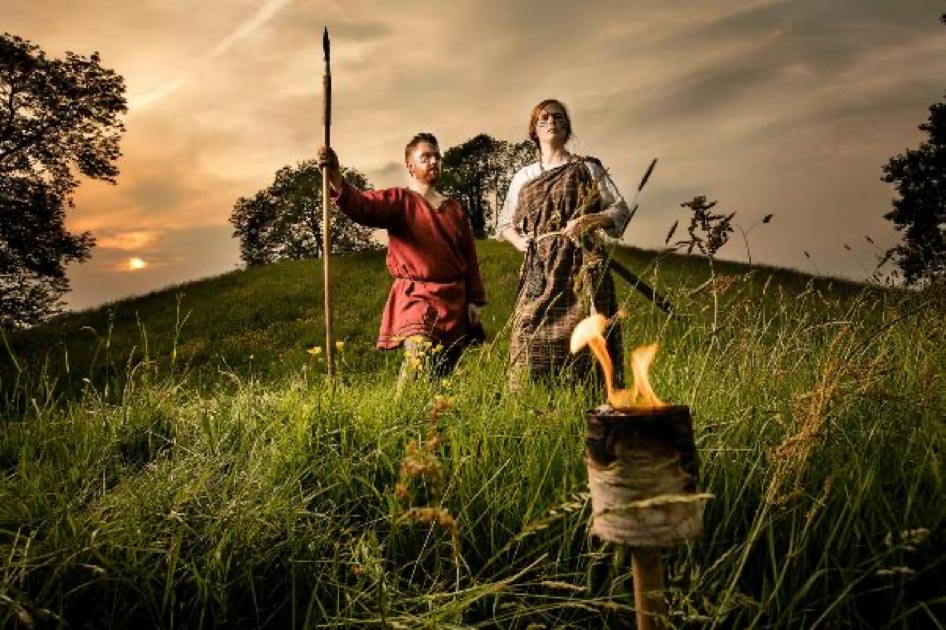Ancient Irish Pagans Made Epic Journeys for Ceremonial Feast
A study of animal remains at one of Ireland’s most important archaeological sites has provided researchers with new insights into the Iron Age, revealing that ancient pagans traveled vast distances for large feasts. The remains of many pigs and other animals, including that of a monkey, found at Navan Fort in Armagh, Northern Ireland, were examined.
Navan Fort is regarded as one of the most important pre-Christian sites in the British Isles. The site was inhabited from the Neolithic period and is mentioned frequently in Irish mythology. A massive roundhouse was located at Navan in the First century BC, which measured over 130 feet (43m) across, a massive structure at the time. It was an important ritual center and also the political capital of ancient Ulster.

Navan Fort, Armagh, Northern Ireland. (Giuseppe Milo /CC BY 2.0)
Iron Age Animal Bones
Recently a number of animal remains found at the site have been analyzed by researchers, in an effort to obtain insights into Navan during the late Iron Age. The study was led by Dr. Richard Madgwick of Cardiff University, working with researchers from Queen's University, Belfast and Memorial University of Newfoundland in Canada. Experts from the British Geological Survey also collaborated on the project.
- Would You Like to Try the King Midas Feast? Chemical Analysis Revealed it was a Slap-up Meal
- Viking feasting hall discovery resembles Beowulf hall of Heorot
- How Feasting Rituals Helped Lead to a Civilized World
The remains of 35 cows, sheep, and pigs were examined. The team found the bones of many pigs at the site of the fort. At the time, these domesticated animals were not as common as they had been in earlier or later eras. Atlas Obscura quotes Dr. Madgwick as stating that “Pigs are a very peripheral species at the time.”

Navan fort. (Airchaeology)
An Ancient Irish Feast
Pigs, because they were so rare, were probably a delicacy. Madgwick told The Belfast Telegraph that the numerous pig bones found “suggests that Navan Fort was a feasting center.” There is documentary evidence in early Irish literature that pork was consumed at feasts and was very popular. Finbar McCormick, of Queen’s University said “Feasting, almost invariably associated with sacrifice, was a social necessity of early societies,” reports The Daily Express.
Researchers took samples from the animals’ tooth enamel, which is a good way to discover the geographical origin of a subject. The team conducted a multi-isotope analysis on the enamel, which allowed them to discover where the pigs and other animals originally came from. The study lead is quoted by The Daily Express, saying that “Our results provide clear evidence that communities in Iron Age Ireland were very mobile and that livestock was also moved over greater distances than was previously thought.”
People brought pigs from all over ancient Ulster to feast at the fort. This is similar to recent findings from Stonehenge. It is probable that the animals were brought to the location by those who were paying homage to the local ruler. It is not known if the pigs were all consumed at one time or at several feasts. Pig meat was typically eaten quickly in ancient times as it tends to go bad quickly.
For the ancient Irish, the pig was an important animal. Atlas Obscura quotes Madgwick as stating that “You had to bring a pig in order to be part of the feast.” By attending such events, the feasters were able to acquire social status and prestige. It is clear that the consumption of food was of great social and cultural importance in Iron Age Ireland.
- Would you enjoy this 4,000-year-old Hittite feast?
- Ancient British Bake Off? Cauldrons Fit for Feasting Found at Iron Age Settlement
- Prehistoric Britons Brought Pigs From As Far As Scotland For Stonehenge Feasts

Navan centre and fort, Armagh. (Visit Armagh)
And the Mysterious Monkey Skull
Also found at the site was the skull of a primate, a Barbary macaque, which originated in North Africa. This indicates that ancient Ulster may have had extensive trading contacts with other areas. It is not known if the animal was eaten or was kept as a pet. The study’s lead researcher stated the remains of the monkey show “the significance of Ulster as a cultural center, one where not only locally-sourced animals were brought, but also creatures from abroad,” reports Atlas Obscura.
The study of the bones revealed new insights into ancient Irish culture and society. Navan Fort was not only a royal and ritual site, it was also a social and cultural center. Pigs played a very important role in traditions. The discovery of the monkey skull shows that Ulster in ancient times was linked to a wider world as well.
Top image: An ancient Irish feast used to take place at important times at what is now known as the Navan Centre and Fort. Source: Visit Armagh
By Ed Whelan

















